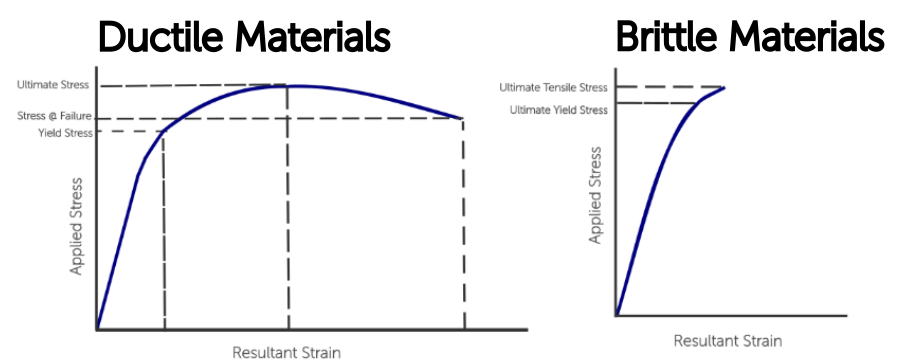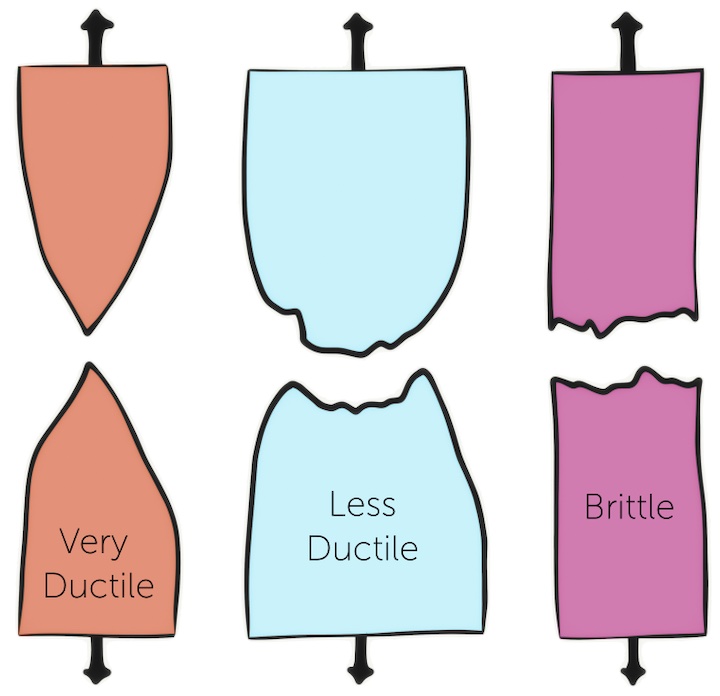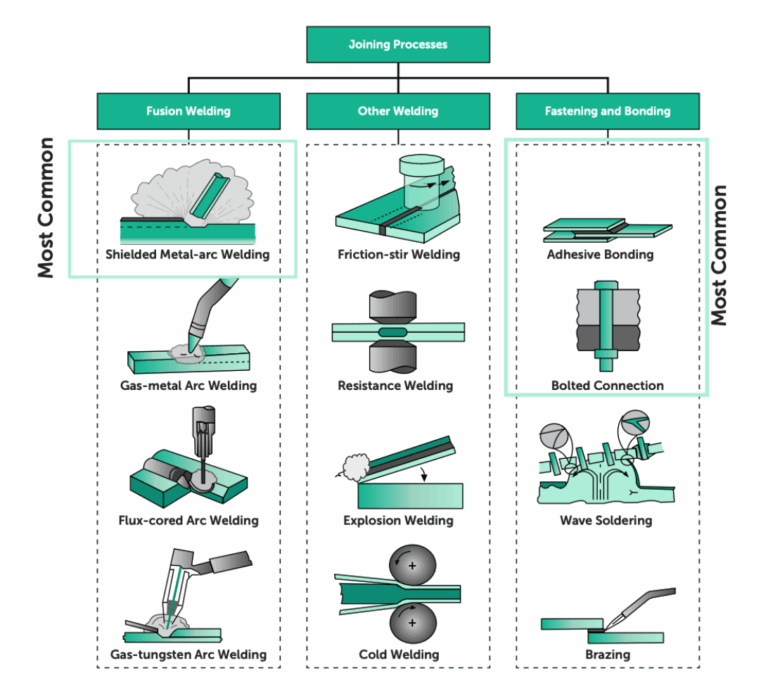Time to read: 5 min

What do you call a brittle superhero? Fragile-man!
When you think of brittleness, what comes to mind? Maybe a piece of fine porcelain that shatters when you drop it, or perhaps a window pane that shattered from an errant golf shot. Brittleness is defined not only as the tendency of a material to fracture when subjected to stress, but also a low tendency to deform before breaking. Brittleness is essentially the opposite of ductility, or the ability of a material to plastically deform before failure — a ductile material can be drawn into thin wires, but a brittle material can’t.
A brittle material will experience far less deformation before failure than a ductile material, which is known as brittle behavior — and it’s critical to understand brittle behavior in order to create effective designs.
Pro-Tip: If you want a refresher on ductility, check out Engineering Fundamentals Refresh: Ductility, Strain, and Toughness.
What Makes a Material Brittle?
Strain is characterized by a material’s change in length divided by its original length under loading conditions, and brittle materials have a lower strain value before they fail. You calculate strain with the following equation:

For brittle materials, there is very little change in length or deformation before failure, so we can characterize brittle materials by:
strain at failure point = ∈ f < 0.05
For ductile materials, the strain at failure is greater than or equal to 0.05, and this relationship provides a method for testing whether or not a material is ductile or brittle.
Because of this low strain value before failure, brittle materials do not exhibit plastic deformation before failure — they fail only after a small amount of elastic deformation as compared to ductile materials, which do exhibit plastic deformation before failure. You can see the stress vs strain curves of brittle and ductile materials below:

Some brittle materials always behave in the manner above, but other materials are susceptible to brittle fracturing. Ductile materials may fail due to a brittle fracture if exposed to certain conditions, such as cyclic loading, impact loads (rapid static loading), low-temperature loading, or parts with defects in their material structures (inclusions, contaminants). Also, certain materials that have undergone processing like welding, hydrogen embrittlement, or hardening may be more susceptible to brittle fracture even though they are considered ductile.
While all of the above are causes of brittleness, the common theme is that ductile materials may fail due to a brittle fracture if exposed to high stress concentrations. Brittle materials are more susceptible to brittle fracture, but it’s still necessary to evaluate stress concentrations for ductile materials, depending upon processing and environmental conditions. Brittle fracture is the failure mode you should be most familiar with when designing and utilizing ductile materials, because this instantaneous failure causes irreparable damage and has a devastating impact on any mechanical system.
Examples of Brittle Materials
Here are some examples of brittle materials:
- Gray cast iron
- White cast iron
- Ductile materials exposed to high stress concentrations under certain environmental conditions (i.e., materials at low temperatures)
- Glass
- Ceramics
- Graphite
- Concrete
Pro-Tip: If you want to see if your material is more susceptible to brittle fracturing, look at the ratio of the yield strength to the ultimate strength — a higher ratio means a higher likelihood of brittle fracture since the material is not as able to absorb energy in the plastic deformation region of the stress vs strain curve.
The Metallurgy of Brittleness
On an atomic level, in ductile materials like metals, the metallic bonds between the atoms allow them to slide past each other, making them, well ductile (kind of more flexible). This flexibility in form is due to the fact that when a metallic bond forms, a network of metal atoms dispersed with surrounding electrons that can move is created — which is also why metals conduct heat and electricity so well. These bonds are strong but also flexible, which adds strength and ductility.
Brittle materials, like ceramics, have atoms that are joined together with ionic bonds — which gives them resistance to deformation. Because the structure formed in ionic bonding comes from electrostatic attraction between positive and negative charges, when those different charges are moved, there is resistance. This resistance is technically called electrodynamic repulsion, and it causes rows of atoms to slide past other rows and ultimately results in fast fracturing before plastic deformation can occur.
Brittle Material Fracture Criteria Theories
While ductile materials follow general yield criteria theories such as Maximum Shear Stress, Distortion Energy, and Ductile Coulomb-Mohr, we need to look at fracture theories for the failure of brittle materials, such as:
- Maximum Normal Stress (not really the most accurate representation)
- Brittle Coulomb-Mohr (provides a conservative estimate)
- Modified Mohr (most accurate)
- Smith-Dolan locus (for the first quadrant fatigue failure)
This is because, in part, brittle materials do not exhibit the same yield strength properties when failing as ductile materials do. So, you should consider the compressive and ultimate tensile strength of brittle materials, as they are not the same for brittle materials. (Remember: most ductile materials have the same yield strength in compression and tension.)
How Do Brittle Materials Behave Under Tensile Loading?
Brittle materials behave slightly differently under compressive and tensile loading, and also behave differently than ductile materials under tensile loading. It’s important to note that brittle materials are stronger in compression than in tension, as their compressive strength is often several times higher than their ultimate tensile strength.
When a tensile test is performed on a brittle material, the material exhibits elastic deformation before failure and no plastic deformation, so the material is unlikely to exhibit necking before failure. Instead, brittle materials fail in a plane that is normal to the applied tensile forces. This is evident from the stress vs strain curves referenced earlier in this article for brittle vs ductile materials.

How Do Brittle Materials Behave Under Compression Loading?

When under compression, a brittle material will not deform significantly before failure, and the failure for a brittle material will occur at an angle that is 30-45 degrees from the axis where the compressive stress is applied. This failure occurs along cleavage lines, aka where crystalline materials split along defined crystal structure planes. Alternatively, a ductile material under compressive loading will start to exhibit cracks parallel to the applied loading.
Fictiv – Your Custom Manufacturing Partner
If you’re working on a design using brittle materials, you’ve come to the right place! Here at Fictiv, our manufacturing experts are accustomed to working with a variety of materials and can deliver the quality parts you need no matter what they’re made of.
We offer CNC machining, 3D printing, injection molding, and urethane casting services and with our free, instant DFM feedback and manufacturing guidance you’ll get the high-quality parts you need, fast.
Create an account and upload your design today!










